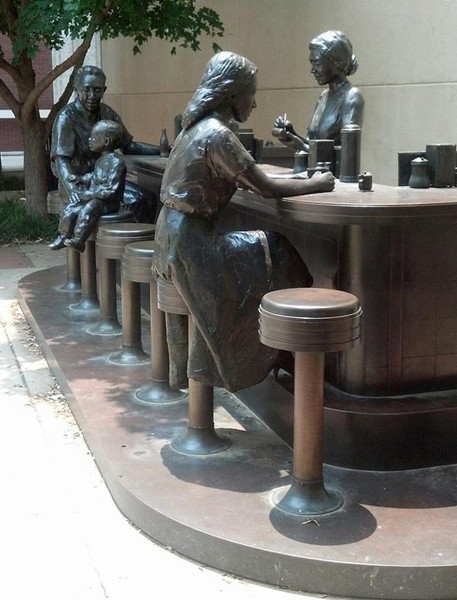Chester I. Lewis Reflection Square Park
Introduction
Text-to-speech Audio
Chester I. Lewis Reflection Square Park opened in September of 2023 and commemorates the life and legacy of Chester I. Lewis, one of Wichita's most important civil rights leaders during the twentieth century. The park contains several large art installments depicting scenes from the local civil rights movement, including the Brown v. Board of Education of Topeka case, Freedom Rides, and sit-ins. Chester I. Lewis was a lawyer and activist in Wichita who worked tirelessly throughout the 1950s, ‘60s, and ‘70s to break down the deep segregation and inequality in his city. Lewis’ value to the progress made towards equality cannot be overstated: he fought injustice everywhere he saw it, including the Boeing Aircraft Company, local public schools, the fire department, housing, local hospitals, and more. He strongly advocated involvement for young people in public life and was known as a man of principle who valued the movement and its goals to support positive change in Wichita.
Images
The park, sitting in front of the Kansas College of Osteopathic Medicine, used to be home to the famous Soda Shop bronze sculpture.

Chester I. Lewis was born in Hutchinson, KS, and moved to Wichita to start his law practice in 1953.

The Soda Shop bronze sculpture, paying homage to the Dockum Sit-ins, was the only monument in the park from its debut in 2002 until the renovation of the park.

Backstory and Context
Text-to-speech Audio
Chester Lewis was born in Hutchinson, Kansas, in 1929. His father, Chester Lewis, Sr., was a mail carrier and a vocal supporter of racial equality, attending local NAACP meetings during Lewis, Jr.’s childhood. Lewis was influenced by his father’s activism and took his parents’ advice to study law as a way to create change. Lewis was also probably influenced by his surroundings in his adolescence: Hutchinson was the only city in Kansas that did not segregate public schools, so he grew up in majority-white schools where he succeeded academically. Lewis attended law school at the University of Kansas, then moved to Wichita with his wife Jacqueline in 1953 and set up a law practice. Immediately, he began his work as a lawyer and activist as a force for change in the city. In 1953 alone, Chester convinced Wesley Hospital to desegregate their infant nursery and influenced the city to desegregate public pools.
Chester is most famously remembered in Wichita for his role in the Dockum lunch counter sit-ins of 1958. At the time of the sit-ins, he was president of the local chapter of the NAACP, and a successful lawyer. When students from the NAACP Youth Council approached him with their plan for a sit-in, he wholly supported them and helped to organize their efforts despite orders from the Association to avoid direct action. The students planned to sit at the Dockum Drugstore lunch counter at Douglas and Market every Thursday and Saturday starting July 19, 1958. Lewis offered emotional support, using his strong leadership skills to motivate the community even when the students faced opposition, as well as free legal services to any protesters arrested. The students continued to sit at the counter every week, and on August 11, the Dockum store manager ceded and announced that the store would serve Black customers. Though Lewis and the students defied the NAACP headquarters' orders by engaging in direct-action protesting, the next year the NAACP awarded Chester Lewis and the chapter a Thalheimer Award, an award given for the highest achievements.
Though the sit-ins are what Lewis is often remembered for, his effort and influence did not end there. He remained president of the local NAACP chapter for eight more years and, during that time, fought several more injustices in the city. In 1958, the Boeing Aircraft Company, the biggest employer for several decades in Wichita, had only 400 Back employees, representing less than one percent of their total workforce. In addition, all Black employees were entry-level, unskilled positions. That year, Chester Lewis complained to the President’s Committee on Government Contracts that Boeing’s hiring practices defied Franklin D. Roosevelt’s Executive Order 8802, which prohibited hiring discrimination in companies that supplied the U.S. military. This led to dozens of Black Wichitans being promoted and hired for engineer and production positions in the company.
One of the biggest battles Lewis fought, which spanned most of his career, was the battle for equal schooling. Though Brown v. Board of Education of Topeka was decided in 1954, elementary and middle schools in Wichita stayed effectively segregated for two decades. After Brown v. Board was decided, many white Wichitans fought for their children’s schools to remain all or majority white. On paper, Black families living in majority Black neighborhoods could opt for their children to be bused to majority white schools. In reality, most families’ requests for these transfers were denied, and many in the community including Chester Lewis felt that this solution put an unfair burden on Black children, while keeping several elementary schools and one intermediate school virtually all Black. Lewis led the fight by submitting a formal complaint to the federal Office for Civil Rights of the Wichita school district’s noncompliance in desegregating, which led to an official investigation into school segregation in the city, and an eventual lawsuit against Unified School District 259. The district proposed several plans that Lewis and others publicly opposed because they did not truly address the issue of de facto segregation. Lewis also served as a witness in the government’s case against the school district. After a long battle between the Wichita school board and white elites, the Wichita Black community, and the federal government, on May 17, 1971, the school board agreed to a plan that would close almost all Black majority elementary schools and bus students of all backgrounds to schools throughout the city to maintain diversity.
Many Wichitans know the story of the Dockum sit-ins of 1958 and remember the desegregation of busing in Wichita public schools, but this park is one of the first monuments to Chester Lewis, a man who spent his career fighting for racial equality in all sectors of Wichita. Ronald Walters, the Wichita NAACP Youth Council president during the sit-ins, argued that while the Greensboro sit-ins may not have been directly connected to events in Wichita, the Dockum sit-ins were a spark that contributed to the flame of the protest that culminated in a wave of sit-ins two years later. Chester Lewis was a hero not only for Wichita but for the entire country, as a symbol of the Civil Rights movement and the successes won by many people. As Chester Lewis’ daughter Brenda Lewis stated at the park’s 2023 debut, “the history of Wichita, Kansas cannot be told without Chester Lewis.” This park will be a lasting tribute to Chester Lewis’ monumental contributions to the city of Wichita and the Civil Rights movement.
Sources
Cassel Eick, Gretchen. Dissent in Wichita: The Civil Rights Movement in the Midwest, 1954-72. Chicago: University of Illinois Press, 2001.
"Chester I. Lewis Reflection Square Park." City of Wichita Park and Recreation. https://www.wichita.gov/ParkandRec/CityParks/Pages/ChesterILewis.aspx
Letter from Chester Lewis to Josephine Gardenhire, July 10, 1968. In Chester I. Lewis, including NAACP Young Turks, and Lewis Criticism of NAACP, from Library of Congress
Walters, Ronald. "The Great Plains Sit-In Movement, 1958-60." Great Plains Quarterly 16, no. 2 (Spring 1996): 85–94.
U.S. Commission on Civil Rights. "School Desegregation in Wichita, Kansas." U.S. Commission on Civil Rights, August 1977. https://www2.law.umaryland.edu/marshall/usccr/documents/cr1204523.pdf
"Chester I. Lewis Reflection Square Park." City of Wichita Park and Recreation. https://www.wichita.gov/ParkandRec/CityParks/Pages/ChesterILewis.aspx
"Chester I. Lewis Reflection Square Park." City of Wichita Park and Recreation. https://www.wichita.gov/ParkandRec/CityParks/Pages/ChesterILewis.aspx
